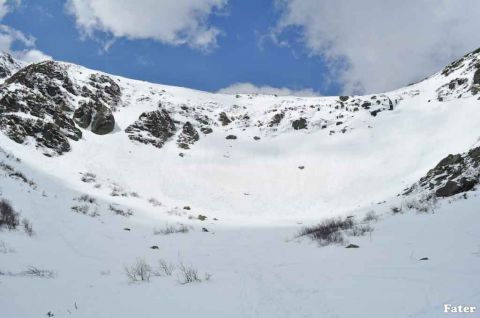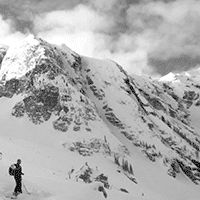Spring Skiing at Tuckerman best In Decades
Tuckerman's Ravine has been on my list for a long, long time now, but since I reside in the West the likely hood of getting to ski this legendary locale is slim to none. Great to hear that the East's huge snowfall from this winter (hey, maybe this is where all our snow went?) is providing better than normal spring ski touring at Tuckerman's. Hopefully all you East coasters are getting out there.

It’s a given: on spring weekends, if there’s good weather forecast, by 7 am the Tuckerman’s Ravine parking lot will be overflowing with hundreds of cars.
Tuckerman’s is one of the most storied backcountry ski slopes in the country, and every spring thousands of skiers brave avalanches and ice-falls to test themselves against the steep slope. On a crowded day, there are estimates that as many as 3,000 people make the trek up to the bowl.
It’s a 3-mile trudge through the woods and across blinding snowfields to the top of the Tuckerman headwall, and that whole way, hikers are laden with skis, boots, water and other gear.
“I don’t understand why people do this for fun, but I think it will be worth it, to get to the top and snowboard down,” says Matt Riley, who drove ten hours from Annapolis Maryland, and as he haltingly lugs his snowboard into the bowl.
Since the 1930s crowds of thousands of skiers have been making the pilgrimage to Tuckerman’s. They come for the copious amounts of snow that blow off the summit of the highest peak in the Northeast, Mount Washington, and settle about 75 feet deep in ravine’s bowl-shaped glacial cirque.
And Tuck’s has its own legends. The central one is the story of Austrian, Toni Matt, “schussing” the headwall. In a 1939 race from the top of Washington, on wooden skis and leather boots, Matt miscalculated the pitch of the slope and bombed straight down the steepest part
“People that were there still recall the sound that the flapping of his baggy ski pants made as he ripped by the spectators.” says Jeff Leich executive director of the New England Ski museum.
Between runs skiers gather at the bottom of the bowl to watch the others making their turns and crashes. The crowd watches, eating and drinking, and shouts a collective “oooooh” for every impressive crash. Every year a few dozen people are injured at Tuck’s. Regardless, the biggest cheers are reserved for those who crash hard, but get up unhurt.
Occasionally there are fatalities – skiers fall into deep crevasses, are caught in avalanches, or are hit by falling ice. Pierre Camirand, from Boston, is among those braving the danger to sun on at a granite outcrop called the Lunch Rocks. These rocks are notorious for the impressive ice flows that loom above them and sometimes slide loose.
“There is a sign at the bottom that says something along the lines of ‘ice the size of automobiles travels at high rates of speed, and hits rocks and sends deadly shrapnel in all directions. Be ice smart,’” Camirand says, but notes that he and his friends are watching the ice carefully, and have positioned themselves so they dive behind a large boulder for protection if need be.
The upper slopes of the climb are so steep that you can easily put your hands onto the snow in front of you while standing up straight; some climb on all fours. Skiers hurtle past.
Eric Meyer’s dog chases a passing skier down Right Gully. Meyer drove up from the Bronx to get his turns. “First time I’ve ever been interviewed on a 45 degree slope,” he chuckles.
He sums up the allure of Tuck’s: it’s a pocket of the terrain found in the Rockies, a rarity here in the East. And with no lifts or lodge, skiing here is pretty close to what it was like nearly a century ago.
“Having grown up in Colorado it’s exciting to have some real steep terrain,” Meyers reflects, “So, you get out here and it’s quiet and you’re just you and your legs working hard getting up the hill.”
Skiing at Tuckerman’s peaks in April and early May, when avalanche danger drops but there’s still plenty of snow. This year, the old-timers say the snow is better than it’s been in decades.
By SAM EVANS-BROWN of NHPR.org







